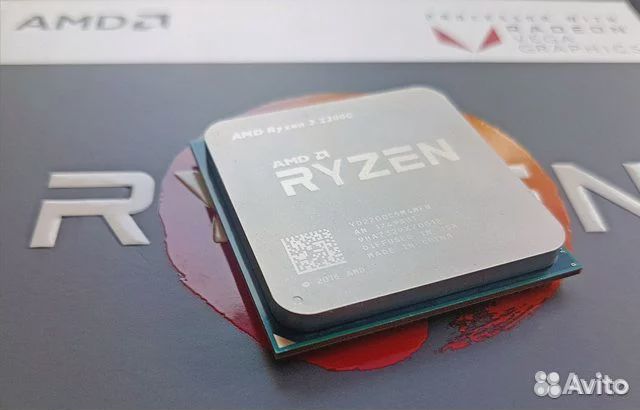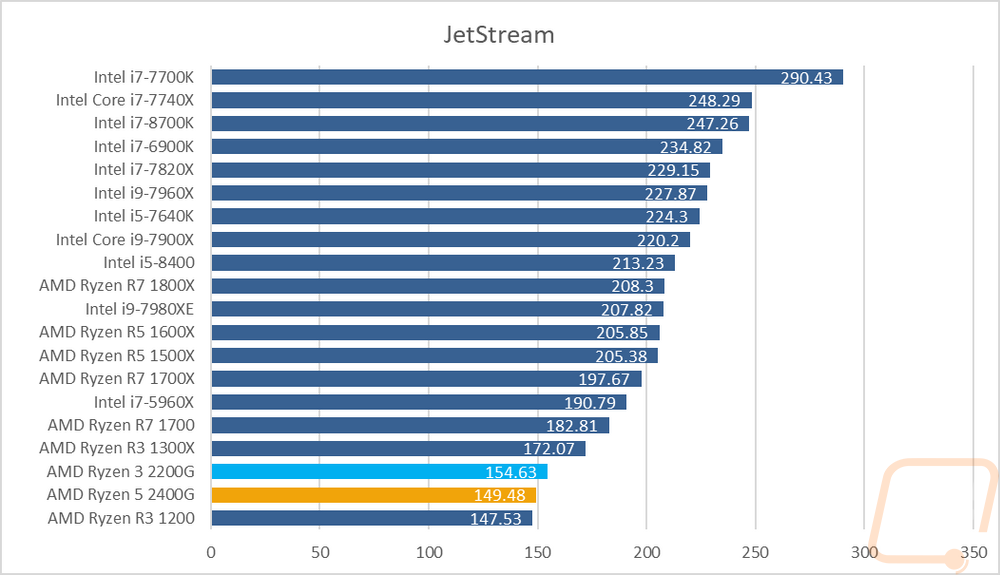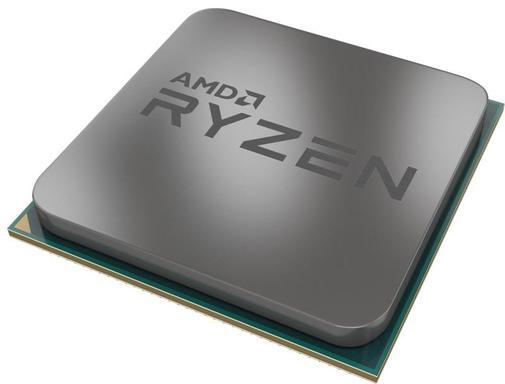AMD Ryzen 5 2400G And Ryzen 3 2200G Review: Raven Ridge Desktop Debuts
AMD continues its assault on the desktop PC market with a pair of new, affordable APUs today, the Raven Ridge-based Ryzen 3 2200G and Ryzen 5 2400G. At this point, if you follow PC technology with any sort of regularity, you’re probably familiar with Raven Ridge. AMD has been talking about its plans to mate the Zen CPU and Vega GPU microarchitectures for quite some time and has revealed a number of details regarding these new hybrid chips over the last few months. In fact, some feature additions and initial specifications were just revealed as the CES 2018 show kicked off a couple of weeks back.
Today though, we can give you the full scoop. We have had the Ryzen 3 2200G and Ryzen 5 2400G APUs in house for a few days now and have put them through their paces with an array of benchmarks. We’ve got CPU and GPU tests on tap, along with some power and temperature data, and overclocking thrown in for good measure. Check out the Ryzen 3 2200G and Ryzen 5 2400G’s main features and specifications below and then we’ll dig in a little deeper and see how these puppies perform with a variety of workloads…
|
Find The Ryzen 3 2200G and Ryzen 5 2400G APUs @ Amazon.Com
We can’t discuss Raven Ridge without mentioning Zen, Vega, and Infinity Fabric. We have covered AMD’s Zen CPU microarchitecture and the Vega GPU at length in the past, so we won’t re-hash the meaty technical details again here. We will, however point you to a few articles should you need a refresher. In this piece, we cover all of the features and capabilities of the Zen CPU microarchitecture, including SenseMI, Precision Boost, XFR, and more. In this piece, we cover all of Vega’s technical attributes, we have benchmarks here, and all three pieces are sprinkled with details of AMD’s Infinity Fabric, which ties all of the company’s IP together over high speed communication links.
In this piece, we cover all of Vega’s technical attributes, we have benchmarks here, and all three pieces are sprinkled with details of AMD’s Infinity Fabric, which ties all of the company’s IP together over high speed communication links.
There are six main clients linked together on Raven Ridge with AMD’s Infinity Fabric. The APUs consist of a single, monolithic piece of silicon (it is not an MCM) with a die size of 209.78mm2, comprised of roughly 4.9B transistors. A Zen processor core complex (CCX) with quad-CPU cores and a Vega graphics engine (with 11 or 8 CUs), are linked to multi-media and display engines, along with the DDR4 memory controller and IO.
The model numbers of these new APUs may give the impression that AMD just bolted Vega onto the Ryzen 5 1400 and Ryzen 3 1200, tweaked the clocks, and called it a day, but that is not the case. These first Raven Ridge APUs have only a single CCX, whereas first-gen quad-core Ryzen processors had two, but with fewer active cores in each. A Ryzen 5 1400, for example, had a 2+2 CCX configuration, with two active CPU cores in each CCX. The Ryzen 5 2400G has only a single, quad-core CCX. This configuration has the benefit of lowering latency should workloads have to bounce between threads, but this comes at the expense of L3 cache. Raven Ridge has 4MB of available L3 cache, while a first-gen Ryzen 5 1400 (and other Ryzen processors with a 2+2 CCX configuration) has 8MB. The number of PCIe lanes available with Raven Ridge has been reduced as well; there are only 8 GPU PCIe lanes available versus 16 in standard Ryzen desktop processors (sans GPU).
A Ryzen 5 1400, for example, had a 2+2 CCX configuration, with two active CPU cores in each CCX. The Ryzen 5 2400G has only a single, quad-core CCX. This configuration has the benefit of lowering latency should workloads have to bounce between threads, but this comes at the expense of L3 cache. Raven Ridge has 4MB of available L3 cache, while a first-gen Ryzen 5 1400 (and other Ryzen processors with a 2+2 CCX configuration) has 8MB. The number of PCIe lanes available with Raven Ridge has been reduced as well; there are only 8 GPU PCIe lanes available versus 16 in standard Ryzen desktop processors (sans GPU).
AMD aims to offset the potential performance penalty of a reduced L3 cache size in a couple of ways. Raven Ridge APUs have higher clocks than their first-gen counterparts. The Ryzen 5 2400G’s clocks range from 3.6GHz – 3.9GHz (base / boost) and the Ryzen 3 2200G clocks-in at 3.5GHz — 3.7GHz (both chips have a 65W TDP). These new APUs also employ Precision Boost 2. The new Precision Boost 2 algorithm is designed to improve performance, responsiveness, and power characteristics. It employs the same 25MHz granularity of Precision Boost 1, but intelligently boosts to the highest possible frequency until a thermal or power limit is reached and continually adjusts each of the CPU core frequencies. The original Precision Boost essentially had only two states – “all core” and “two core” boost, and that was it.
The new Precision Boost 2 algorithm is designed to improve performance, responsiveness, and power characteristics. It employs the same 25MHz granularity of Precision Boost 1, but intelligently boosts to the highest possible frequency until a thermal or power limit is reached and continually adjusts each of the CPU core frequencies. The original Precision Boost essentially had only two states – “all core” and “two core” boost, and that was it.
The Ryzen 5 2400G is a quad-core / eight-thread machine with an on-die, 11 CU (compute unit) Vega graphics core with 704 stream processors, priced at $169. And the Ryzen 3 2200G is a quad-core / quad-thread chip with an 8 CU Vega-based graphics engine with 512 stream processors for only $99. Externally, the APUs look just like any other Ryzen processor designed for the AM4 platform, but there are actually some differences with the packaging here as well. AMD is switching to a non-metallic TIM for the 2400G and 2200G, and the new CPU package allowed the company to officially support JEDEC DDR4-2933 memory speeds as well.
The Ultimate Choice For Budget PC Gaming?
If you’re looking to build a gaming PC but want to spend as little as possible — we’re talking about $500 or less — AMD has just released two seriously interesting products that look set to beat Intel at the low-end and offer those on super-tight budgets a way to get into PC gaming for very low amounts of cash.
The Ryzen 5 2400G and Ryzen 3 2200G are what’s called APUs — CPUs with a capable onboard graphics processor and despite the fact they offer gaming performance on par with $50-100 discrete GPUs, they’re available from just $99. I’ll be reviewing both in this article and you can see the full results on the next few pages.
Ryzen 5 2400G — Price: $169.99
Ryzen 3 2200G — Price: $99
Antony Leather
AMD confirmed details of its Zen-based APUs with Radeon RX Vega Graphics back in January, and since then we’ve been keenly-awaiting the company’s first desktop products with onboard graphics under the Ryzen brand — all the rest have been CPUs that required a discrete graphics card.
The company has had some success here in the past too, with FX-series APUs offering acceptable performance in games at low settings, removing the need for a separate graphics card for those on tight budgets. The fact that, in the case of the Ryzen 5 2400G And Ryzen 3 2200G I’m looking at today, we’re talking about Radeon RX Vega graphics built-in, means that there’s no need to buy a discrete graphics card if you’ll be gaming at low resolutions and detail settings, meaning you can save up to $100.
Antony Leather
Until Ryzen and the Zen architecture arrived last year, AMD’s performance elsewhere was lacking, so the fact its two new APUs sport full-fat Ryzen quad-core CPUs under the hood means you get plenty of grunt outside of games too. The Ryzen 5 2400G even supports Simultaneous Multithreading, so you get eight threads as well as four cores too — that’s the same as the Ryzen 5 1500X which costs the same price but lacks any onboard graphics.
| AMD Ryzen 5 2400G | AMD Ryzen 3 2200G | AMD Ryzen 5 1400 | AMD Radeon RX 560 | AMD Radeon RX 550 | |
| Price | $169 | $99 | $149 | — | — |
| CPU cores | 4 Cores, 8 Threads | 4 Cores, 4 Threads | 4 Cores, 8 Threads | — | — |
| Base Clock | 3.6GHz | 3.5GHz | 3.2GHz | — | — |
| Max Boost Clock | 3.9GHz | 3.7GHz | 3.45GHz | — | — |
| GPU Cores | 11 Compute units | 8 Compute units | — | 16 Compute units | 8 Compute units |
| GPU Clock max | 1250MHz | 1100MHz | — | 1275MHz | 1183MHz |
| L2 cache | 2MB | 2MB | 2MB | — | — |
| L3 cache | 4MB | 4MB | 8MB | — | — |
| TDP | 65W | 65W | 65W | 75W | 50W |
| PCI-E lanes | x8 | x8 | x16 | — | — |
The above table includes details not just for the Ryzen 5 1400 CPU, but also for the RX 560 and RX 550 graphics cards so you can compare their specifications to those of the new APU’s Vega-based graphics processors. The clock speeds are similar, but the RX 560 has a clear lead in compute units. However, you can probably expect the Ryzen 5 2400G to offer the $100 RX 550 some competition in most games, with its onboard GPU sporting three extra CUs and a faster GPU core frequency.
The clock speeds are similar, but the RX 560 has a clear lead in compute units. However, you can probably expect the Ryzen 5 2400G to offer the $100 RX 550 some competition in most games, with its onboard GPU sporting three extra CUs and a faster GPU core frequency.
Two notable limitations of the new APUs compared to their older Ryzen counterparts are the number of PCI-E lanes available for the GPU — just eight compared to the usual 16, plus the L3 cache is half that of the Ryzen 5 1400 at just 4MB. However, the new APUs sport AMD’s improved boosting technology — Precision Boost 2, which promises to increase performance particularly in lightly-threaded workloads.
AMD
Now, let’s get one thing straight. We’re not looking at a monstrously powerful graphics processor here. The Ryzen 5 2400G only has 11 compute units meaning it’s going to be competing roughly with AMD’s RX 550, RX 560 and Nvidia’s GTX 1030 — the latter I managed to get hold of in time for this review and you can see how it compares in the graphs later on.
AMD
What this does mean, is that if you’re hoping to play recent demanding 3D games at 1,920 x 1,080 at maximum detail settings, you’re going to be disappointed. You’d still need to splash out a few hundred dollars to get something like a GTX 1060 before you get silky smooth frame rates in many of today’s 3D titles. Unsurprisingly, the GTX 1060 currently tops Valve’s hardware survey as having the biggest market share of any graphics card at the moment.
However, at the low end of the spectrum, and indeed getting into the top 15 most-popular graphics cards in the survey are plenty of low-end options that include the likes of Intel HD graphics, Nvidia’s GeForce GT 730 and AMD’s Radeon R7 series. If you’re gaming on something similar, you’ll probably be well-versed in tuning down your game settings and you may even be gaming at resolutions lower than 1080p too.
